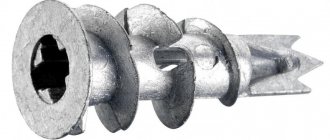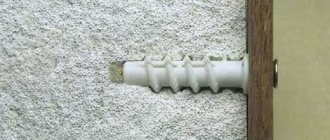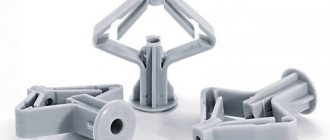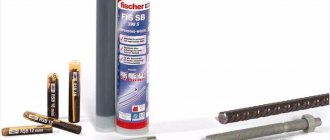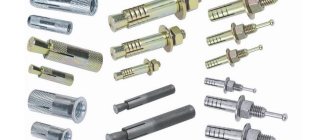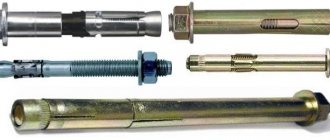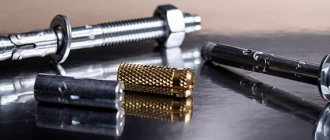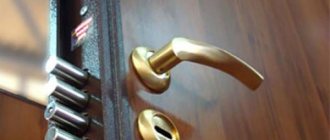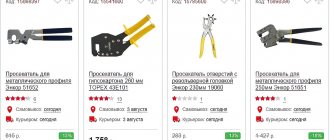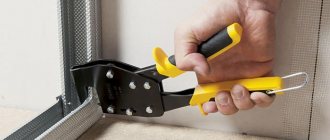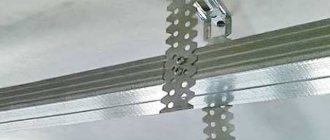Installation of dowel nails using a special gun
All the previously described options for driving dowel fasteners imply that the nail is driven into the dowel. But there is another way to install the mount in question, which involves using a construction gun. This modern installation device allows you to “shoot” the structure being fixed to the base using a dowel-nail.
In this case, a special dowel fastener is used, which by and large does not involve the use of the dowel itself. The presence of a special washer on the nail ensures a tight fit of the fastener into the solid material.
The essence of the technology for operating the gun is that after shooting the dowel-nail, the washer on its tip moves to the head of the fastener and is tightly fixed there.
This dowel-nail is used when fastening metal structures to solid bases made of natural stone, concrete, steel with low carbon content, and brick. The gun and the described type of fastener are very often used when installing canopies on the balconies of buildings.
They produce “nails with washer” with a length of 30 to 80 millimeters, a cross-section of 4.5 and 3.7 millimeters from steel coated with zinc. It is extremely rare to find nails with a cross-section of more than 4.5 millimeters on sale.
I think you already understand how to use a dowel-nail. Humans do not encounter any particular difficulties with this fastener.
In this case, it is very important to choose the right type of fastener, since dowel-nails, which, for example, perfectly connect the surface and the concrete base, are absolutely not suitable for fastening chipboard or plasterboard
It is enough to contact the consultants (sellers) of a hardware store that sells various types of fasteners (for example, slate nails or finishing nails) to obtain comprehensive information about the types of dowel devices.
They will also advise you on how to use dowel nails. However, after carefully reading the article we have prepared, you will probably no longer need this information. You can easily mount fasteners into any type of surface without outside help!
Distinctive features of dowels for brick and concrete
A clear definition for fasteners is the fundamental principle that you will choose the right fastener and, accordingly, get the expected result after its installation. In practice, dowels for hard materials are not very advisable to use on brickwork. Moreover, if such a wall consists of bricks with voids inside. A fastener for concrete foundations is not at all what you need in this situation.
For such a base, there is a special dowel for bricks with voids inside; it has a special structure and, accordingly, installation specifics. First of all, it is an elongated plastic or metal bushing, the structure of which has a double thrust system mechanism. This design guarantees reliable fastening only for the reason that one of the spacers in any case ends up on a solid base, where it is fixed.
A threaded rod of the appropriate diameter, a self-tapping screw and other anchor fastening elements can be used as a rod, which plays the role of a spacer element. It all depends on what exactly you need to mount on the wall, and how much force a particular device will exert on the mount. Naturally, an important point before installation is the choice of the length of the fastening element. But you should not choose fasteners that are too long; in the future, difficulties may arise when installing the fastening device.
But the dowel-nail for concrete is technologically designed to work on a completely different principle. For example, in a hollow material it will never create a strong fastening connection, no matter how long we use it. The process of installing such fasteners itself involves driving it into the hole, which significantly speeds up installation work. In loose materials, using this technology, we will simply destroy the mounting hole and will not achieve high-quality fastening.
Kinds
There are several types of dowels that allow you to attach suspended structures to gypsum boards:
- Butterfly.
- Driva plastic or metal screwdriver.
- Molly.
- Fischer dowel.
- KNAUF Hartmut.
- An ordinary dowel-nail.
- Spring-loaded.
Each of these types of fasteners has advantages and disadvantages. To figure out which one is more profitable to use in a specific situation, let’s take a closer look at them.
What is a dowel-nail
A dowel-nail is a special product used to perform fastening work. It consists of two elements - a special nail and the dowel itself, and is used for mounting objects to concrete, brick, stone, and other solid, dense materials. There are also types of the described fasteners designed to work with chipboards and drywall.
The design of the dowel-nail is very simple. It is made in the form of a cylindrical rod, which consists of a spacer part (it expands during installation and allows for reliable fastening) and a nail that is familiar to everyone.
In some cases, the fastener we are interested in may be additionally equipped with a special cuff that acts as a limiter that does not allow the fastener to fall into the hole made. The shape of this cuff can be different, for example, cylindrical or hidden.
Also, modern industry produces dowel fasteners with a thread applied to the nail and a slot, which is located on the head of the product. This element can be mounted using a screwdriver. Working with it is quite simple, since the process of inserting a nail into a dowel is made easier due to the presence of a “smoothed” thread in the product. Let us add that the top of the thread of this mounting device is directed towards the head. Purely externally, the dowel-thread is no different from the standard thrust thread.
Most often, dowels are made from polyethylene, polypropylene or polyamide. But the dowel-nail itself is made from steel alloys with a zinc coating. To be fair, we note that there are many fasteners of the described type on the market without additional coating. Standard dowel diameters are 5, 6, 8 and 10 millimeters, and their length ranges from 30 to 160 millimeters.
Dowel-nail how to use it when working with brick and concrete
If you are installing a fastener in a brick structure, you should follow these steps:
- We choose the optimal place for the dowel (usually this is understood as the center of the brick).
- Using an impact drill, we begin to drill into the material. This process must be performed very carefully (especially when starting drilling) so that the masonry does not crack under the influence of the tool. You can increase the speed of the drill after about 10 millimeters of brick have been drilled.
- From the resulting hole, we blow out brick crumbs and the resulting dust with a vacuum cleaner, after which we boldly hammer in the fastener using a hammer.
When working with concrete surfaces, the fasteners are mounted as follows:
A hole is marked with a punch and a hammer. A hole of the required depth is punched (with a hammer drill). Please note - the marking of the dowel-nail, which indicates its cross-section, must coincide with the marking of the drill
It is also important that the length of the dowel is 5–6 mm shorter than the hole being punched. Using a vacuum cleaner, concrete dust is removed, and then the dowel cartridge is deepened with a hammer. After all these steps, the nail is driven in. It is advisable to leave 2-3 millimeters of free space from its head, which will be required for hanging.
Actions with the cord
This measure can indeed ensure high-quality fasteners.
However, if you need to stretch the cord between the corners (for example, for construction and repair needs), you can do it this way:
- Tie nails and other wire scraps to the nylon thread.
- Insert them into the mortar joint (with a soft mortar, immersion will occur without a pick or other tools).
- In winter, a pick may be needed (as is the case if the solution was yesterday).
- There is no need to hammer the parts too deep, because they need to be constantly pulled out.
In this case, you need to ensure that the rod can support the tensioned cord itself. It is important to pay attention to ensure that the element does not sit too firmly inside.
To do this, it will be enough to loosen it a little in its nest.
General recommendations for driving a comb nail into brick
Another option for 100% quality work is choosing comb options. This material consists of copper elements with sharper edges (this allows you to easily enter any material).
To accomplish your plan, you need to prepare those tools that can help you hammer in a nail, and in the future you won’t have to worry about the thing hanging on the wall. To do this you will need the following preparations:
- roulette;
- the comb nails themselves;
- drill;
- 3 mm drill for concrete;
- hammer;
- pencil.
The work algorithm will be as follows:
- Measure the brick itself.
- Measure the very place where the nail should go.
- Mark the front of the work with a pencil, making a bold dot
- Put the drill into operation.
How to drive a dowel nail into drywall, ceramic or tiles
When installing drywall, you should take into account in advance the weight of the load that is attached to it. In cases where the weight of the load is quite high, it is impossible to use a dowel fastener, since it will simply destroy a fairly light plasterboard surface. In other situations (light load weight), driving a dowel-nail is a very simple procedure:
- a hole of the required cross-section is made in the drywall;
- the fastener is inserted all the way into the hole (in this case, you should not hit the fastening element with a hammer with all your strength, but only lightly tap);
- The screw is tightened manually or using a screwdriver.
When working with tiles made of tiles or ceramics, installation of fasteners is also simple, but the work should be done with extreme caution, given its high fragility. The fastening diagram is as follows:
- a marker marks the point of entry of the fastener into the tile (this can be either a seam or the surface of the material);
- Lightly tapping a metal screw using a self-tapping screw makes a hole on the surface of the enamel (up to 0.5 millimeters), and only after that use an impact drill, which drills through the tile (ceramics) to its entire thickness.
Do not forget that you will also need to make a hole under the tile in accordance with the instructions for brick or concrete (they are outlined above), and then install the fastening device into the tile and brick or concrete surface.
"Har
Champion among fasteners in terms of weight held. Capable of withstanding loads up to 55 kg. It consists of a metal U-shaped bar with locking bushings and two plastic guides.
Installation diagram:
- A hole with a diameter of 13 mm is drilled in the drywall.
- A metal strip is inserted into it. By pulling the guides and aligning them relative to each other, it must be brought into working position.
- The guides are inserted into a clear plastic sleeve. It is inserted into the hole until it stops.
- The ends of the guides move in different directions and then break off.
- The screw included in the delivery set is screwed into the dowel.
Installation of Hartmut fasteners: step 1
Step 2
Step 3
Step 4
Step 5
Step 6
Rear view
The result is a very reliable fulcrum that can withstand heavy loads.
Why do you need a dowel?
A dowel is a specialized fastener designed for installation and connection of various structures. There are a huge variety of different types of dowels, each of which is suitable for a particular material: concrete, stone, drywall, wood and others.
This fastening is most often used when there is no access to the edge of the connecting rod of a conventional screw. That is, when it is necessary to make a non-through hole, for example, to install a cabinet in the kitchen or a shelf in the living room. Also, dowels are ideal for hollow walls. Other fasteners in this situation will simply be ineffective.
The principle of operation of the dowel is very simple. A dowel is a kind of buffer between the self-tapping screw and the wall, fixing the entire structure due to the presence of special ribs and “hooks”. That is, it works like a spacer.
A dowel is a cylindrical rod made of polypropylene, nylon, polyethylene or even metal. Structurally, the dowel has two parts: an expansion one - it expands during installation, securely fastening into the working material, and also a non-expansion one. Some types of dowels are equipped with a limiter cuff that prevents them from falling into the drilled hole.
Features of using dowels
When choosing a dowel, it is not enough to focus on its shape; it is also important to know what size (length, diameter) to choose. For each working surface you need to select your own fasteners
The “six” dowel (6*40) is suitable for installing profile structures in cinder block houses. By choosing a different size, it will not be possible to make repairs, since all the fasteners will simply fall out of the drilled holes.
For panel houses (as well as those where there are no voids in the walls), the best option for dowels is 6*60 or 6*80. With them, everything will be securely fastened, nothing will fall through or fall out even on the ceiling.
When choosing the length of the dowel, it is worth remembering the load that the fastener will be subjected to in the future during operation. The shorter the dowel and self-tapping screw, the less load it will withstand. The diameter is also important. For ordinary housework (hanging a cabinet, mirror or wall unit), dowels with a diameter of 8-10 mm are sufficient.
The only difference is the depth of the hole being drilled, since the load on the dowel is different. For a cabinet, 3-5 cm is enough, and for a wall unit or a heavier cabinet or shelf - 8-10 cm. Another important question that arises before the master is what kind of drill is needed for the dowel.
To answer this, you first need to know what surface will be drilled and what load on the structure is planned in the future after the work is completed.
How to choose a drill for a dowel?
The most important rule is that the drill number must match the number (size) of the dowel. T
That is, ideally, the dowel should be difficult to hammer into the wall, otherwise, a situation is possible when the dowel simply falls out or fails. As for the quality of drills, experienced craftsmen advise using pobedit ones, since buying more expensive ones does not make much sense.
It’s easy to make a hole for a dowel (for example, let’s take dowel 10): First, take a smaller drill, for example a 8-piece. Make the hole slightly smaller in depth than necessary using the impact mode.
Fischer P.D.
One of the newest and most convenient developments in the field of drywall fasteners. The principle of operation is original in that when the self-tapping screw is screwed into the dowel, its conical shank is pressed into the plastic sleeve, forcing the stop wings to open. When the sheet thickness is small, they apply pressure from the back side. If the thickness of the drywall is significant, they will jam the dowel in the drilled hole.
Such fasteners can withstand 12–15 kg. Installing it is simple:
- Preparing a hole in the drywall.
- The dowel is inserted. Longitudinal ribs will prevent it from turning, and a reinforced flange will prevent it from falling into the hole.
- The locking screw is tightened. As it moves, the “wings” open and the dowel is fixed.
Dowel fastener. Types of products
These products are divided into categories according to:
fastening method
The design features, as well as the base material, are taken into account. If the base is of high density, which causes certain difficulties in the process of fastening various elements, you should use dowels for brick or concrete
To work with such surfaces, you can choose: Expansion dowel. Depending on the manufacturer, the product may differ in shape, as well as in the number of teeth, ailerons, and spikes. Universal fastener. In solid materials it manifests itself in the same way as the spacer type, but in hollow materials it shows different qualities. Facade dowel and frame. The products are designed for fastening into dense bases, even if they are classified as slotted. Nail type. Designed for mass quick installation. Most often requires the use of a mounting gun. If the work will be carried out with loose or hollow materials, then in these cases it is better to choose a universal option, frame (can be used when installed in a foam concrete base during the installation of plastic door and window structures), driven (for aerated concrete), as well as screw-on, panel and sheet dowel.
type of installation
In this case, it is not the method of immersing nails into dowels that is taken into account, but the installation of the dowel itself. Today there are two methods: Pre-installation
The fasteners are fixed into the base. The attached element fits as tightly as possible to the “body”. The largest percentage of types of dowels work exactly according to the mentioned principle (universal, nail, spacer). Through installation. Before fastening into the base, the fastener must pass through a void area or a certain layer of intermediate material. To carry out this process, a product with an elongated non-expanding part is used. We are talking about frame, facade, and roofing dowels. In addition, there are models of fasteners for insulation. They can be either spacer or non-spacer. They are distinguished by the presence of a rather large cap (diameter - from 45 to 90 mm), which allows them to hold loose material, as well as soft ones.
- material. Most often, dowel fasteners are made using plastic. This is explained by the fact that the level of installation strength is determined by the ease, as well as the force of deformation. Plastic is endowed with elasticity and viscosity, which allows it to deform more easily than other materials. At the same time, the plastic does not lose its characteristics. Thus, today there are dowels made from the following materials:
- Polyethylene. The products are lightweight and resistant to acids. The raw material is endowed with excellent viscosity and is able to retain its qualities during deformation. Fastening material made of polyethylene is resistant to corrosion reactions and is not subject to cracking after long-term use. It is resistant to low temperatures (used at –40 degrees Celsius).
- Polypropylene. It has high hardness and wear resistance, but cannot be used at very low temperatures. But it performs well at high temperatures (deformation is observed at +140 °C or more).
- Nylon or polyamide. Products made from this material are endowed with a high level of rigidity and strength. They are resistant to mechanical stress and vibration processes, and are durable. A nylon dowel is recognized as a more reliable fastener, but it is not recommended to use it in frosty or humid weather.
Types of fasteners
Construction stores offer a wide range of dowels. Photos of products clearly demonstrate the diversity of their designs, materials of manufacture and purpose.
The most common product is the universal polypropylene dowel. It has a traditional design in the form of a sleeve, into the cavity of which a self-tapping screw is screwed. This element is suitable for concrete, brick and stone foundations. The design of the product is equipped with special spacers, with the help of which the element is securely fixed in the hole.
To perform complex external work, a spacer construction dowel with a locking edge is used, which eliminates the possibility of fasteners falling into the hole.
Nylon dowels are equipped with fastening antennae, thanks to which the products are securely fixed in the holes. They can be used on any surface.
Drywall dowels are used for mounting them into porous concrete and sheets of gypsum fiber and plasterboard. They can be made of plastic or metal. The last option is called dowel molly. Before hammering in a dowel of this type, there is no need to first prepare the hole, since its tip has the appearance of a sharpened drill.
Dowel for plasterboard walls
Facade dowels are made of polypropylene or nylon. They have directional antennae for secure fixation at the base. Such fasteners can be used for any surface. They are produced without sides, which eliminates the possibility of shedding or cracking of the facing plaster.
The frame dowel is intended for installation of door and window frames, cladding through layers of thermal insulation and plaster. The products are made of metal. They are often called thermal insulation dowels, which can be of two types: for working with hard and soft materials.
Types of dowels with special design
Dowel nails are made of polypropylene, nylon or stainless steel. Thanks to the presence of knurling in the form of reverse cones, reliable retention of the product in the base is ensured. They are widely used for quick and extensive installation of skirting boards, sheathing, windows, timber, metal profiles, cable ducts, plywood to concrete, brick or stone surfaces.
Helpful advice! When deciding whether to hammer or tighten a dowel-nail, preference is given to the first installation option.
Butterfly dowel for hollow structures
The butterfly dowel is characterized by increased wear resistance and the ability to withstand high loads even in hollow surfaces. Such products are made of metal.
The adjusting dowel is used to install the sheathing under the sheathing. It has a special design containing a certain element that allows you to adjust the position of the product relative to the surface to which it is attached.
Helpful advice! To carry out large volumes of installation work, it is advisable to use dowels-screws designed for mounting guns.
The dowel-clamp has the shape of a loop with characteristic tendrils for fastening along the edges of the product. Such elements are designed for mounting electrical wiring to the base. The wire is inserted into the clamp, and its edges, in turn, are inserted into holes previously created in the wall and fixed with tendrils.
A special type of fastening element is an umbrella dowel, which is designed for installing thermal insulation made of polystyrene or mineral wool. This product has a wide round cap that holds the insulation. They produce plastic and metal dowels.
An umbrella dowel is often used to hang ceiling chandeliers
Helpful advice! The best option for loose foundations would be liquid dowels, or chemical anchors, which provide a strong and reliable connection and are at the same time able to withstand heavy loads.
The Molly umbrella dowel is a nail with metal arms that provide reliable fastening of structures to hollow surfaces with uniform load distribution.
Helpful advice! To attach the chandelier to a suspended ceiling, you should use Molly umbrella dowels.
